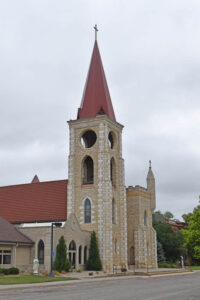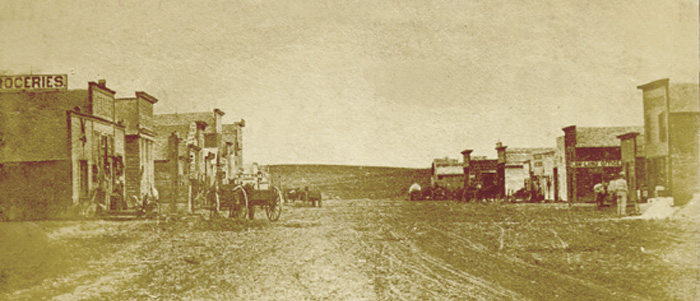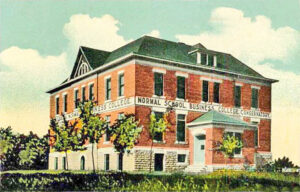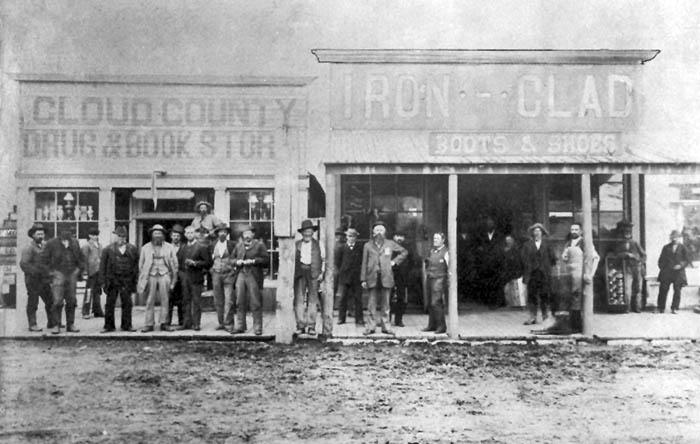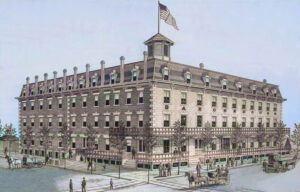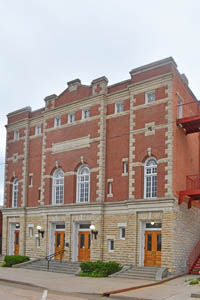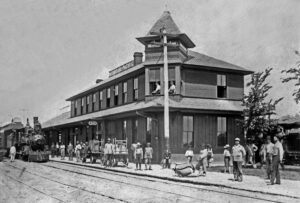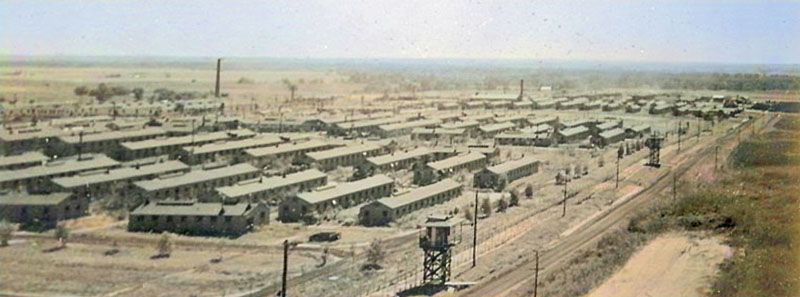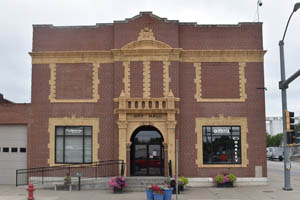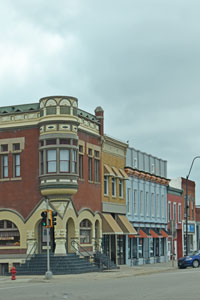Concordia, Kansas, is the county seat and largest town in Cloud County. It is located along the Republican River in the Smoky Hill region of the north-central part of the state. As of the 2020 census, the city’s population was 5,111.
Concordia was elected the county seat before the town was created. The founder of the town, James M. Hagaman, created a complete town layout on paper, including streets, blocks, a courthouse, and parks. It was named “Concordia” because a member of the early group of promoters, “Cap” Snyder, had once lived in Concordia, Missouri, and had paid homage to the German heritage. The word “Concordia” is a German name found in many early Germanic poems.
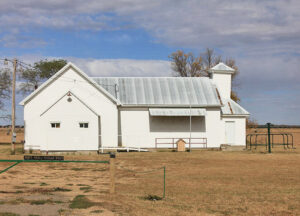
Sibley, Kansas Old School, courtesy Tom McLaughlin, Flickr.
The first election for the county seat was held in December 1869 between Concordia, Clyde, and the now-defunct town of Sibley. At that time, no building existed on the present city’s site. Soon, however, two town companies were organized. The first, composed of G.W. Andrews, S.D. Houston, Sr., and J.M. Hagaman owned what was known as the deeded part of the site. The second company consisting of S.D. Houston, J.J., W.M., and Frank Burns owned the Congressional site. Two surveys were made before the plat was finally adjusted to the satisfaction of all parties. The only houses subsequently embraced within its limits, then in existence, were two small structures owned, respectively, by G. W. Andrews and J. M. Hagaman.
Without a clear majority in the 1869 vote, a second election was held between Concordia and Sibley on January 4, 1870. Concordia was declared the winner over Sibley, with 165 and 129 votes. Soon afterward, a one-story building measuring 16 by 20 feet was erected for the county commissioners’ use. However, only two meetings were held there, and the board adjourned to Clyde, where better accommodations could be secured.
Afterward, E.Linney opened a store in the abandoned courthouse. The Honorable James Strain of Illinois was the next person to commence the erection of a house, and A.A. Carnahan also built one a little later.
A post office was established in Mr. Linney’s store on June 13, 1870, and he became the postmaster. That year, the initial townsite survey was abandoned, and a new one was made in the fall of 1870. S.D. Silvers opened the second store in December, erecting a building on the corner of Sixth and Broadway Streets.
That year, the Notre Dame Catholic Church was made a branch of the Clay Center Church. In 1876, the church was built for $9,500 and the parsonage for $2,500. By the early 1880s, 90 families were in the parish.
The Republican Valley Empire, the first newspaper started at Clyde, was established in 1870 by Henry Buckingham. In the following year, it was removed to Concordia. It was sold to H.E. Smith in 1872 and has since passed through the hands of Honey & Davis, H. R. Honey, Chaffee & English, and is now owned and edited by C. J. English. Mr. English was a young man born in Nodoway County, Missouri, in 1855. He has been a resident of Cloud since 1864, so the Concordia Empire was edited by a man educated in Cloud County. It is, and always has been, Republican in politics and is one of the leading journals of the county.
Upon the recommendation of the Honorable S.C. Pomeroy, United States Senator, and the Honorable Sidney Clarke, Representative in Congress, a United States land office was opened at Concordia on January 16, 1871, in a building erected for $2,000. There was a rush of land applicants, and the town grew accordingly. The office remained in operation until it consolidated with the Topeka office in February 1889.
In January 1871, Henry Buckingham moved the Republican Valley Empire’s publication office from Clyde to Concordia. McKinnon & Co. opened the first lumber yard and hardware store the same month. The Gliddens commenced the erection of a hotel about the same time. Several stores were also established, and by the spring and summer, Concordia was firmly established as a thriving business town. The Honorable C. W. McDonald opened a law office, and H. Lanoue began operating a sawmill.
The Presbyterian Church was organized in June 1871 by Reverend M. P. Jones. Within a decade, it became one of the finest churches in Concordia, and its membership increased from 20 to over 60.
In August 1871, $5,000 in bonds was voted to erect a commodious schoolhouse. The first schoolteacher was Milo Stevens, who was paid $20 per month. In November, the Truesdell House was “seen moving over the prairie from the west.”
The Concordia Mills, owned by H. Lanoue, G. R. Letourneau, A. Berard, A. Gosselin, and E. Gustineau, was first started in 1872 by Mr. Laneaue as a steam grist mill but changed to water power in 1874. The Republican River was not well suited for damming, as its banks were low, and the bottom quicksand was poor. In 1875, 120 feet of the dam was carried away, and the following year, another portion went out, which compelled Laneaue to form a new company. At an expense of about $70,000, they secured one of the best dams on the river with repairs and improvements. There were five runs of burrs, with seven feet head and enough water to run 20 burrs and the necessary machinery throughout the year.
On August 6, 1872, Concordia was incorporated as a city of the third class, with R.E. Allen as the first mayor. By December of that year, the prosperity of the young city was increased by a fire that destroyed $10,000 worth of property – its prosperity was increased because it marked the era of the erection of a better class of buildings, such as Hagaman’s Block, Merchant’s Block, and Union Block.
Brothers-in-law D. W. Williams and Orin Bennett built a malthouse and brewery that year just above the mill. It thriving business for several years.
A big fire occurred on the evening of December 24, 1872. It originated in the Collins & Dennis building, then owned by W.O. Wagoner. Eight buildings were burned, and one was torn down and thrown into the middle of the street, which checked the fire and saved the other nine buildings. The most important building destroyed was the Glidden House, a good hotel for that early day. The fire cast a gloom over the struggling little city, and many predicted that years would pass before it would be rebuilt as well as before. This was Concordia’s first disaster and entailed a loss of about $30,000.
In February 1873, A.J. Shelhammer, N.H. Eaves and J.M. Hagaman began excavating to prepare to erect a stone building on the south side of Santer Street. The two-story building was ready for occupancy in about eight months. The following summer, J. E. Burress began a stone building on the southeast corner of Broadway and Sixth Streets.
The Commercial House, one of the leading hotels in Northern Kansas, was built by Elson Crill in 1873. Later, Crill, along with E.D. Crandall, who became part proprietor, made additions to the hotel. The three-story solidly constructed stone building measured 76 by 50 feet and had a full basement. It contained 55 rooms, was well furnished, and obtained most commercial travel. In the early 1880s, the property was valued at $15,000. Several other small hotels and boarding houses were there, but the Commercial House took the lead.
The Methodist Church was organized in 1874, with Reverend Gray as pastor. This denomination furnished the first sermon preached in Concordia when Reverend R.P. West of Republic County delivered it in the old land office building. By the early 1880s, the church had a good building, a parsonage, and 100 members.
On April 14, 1874, frightful blizzards swooped down upon the area. Eight inches of snow fell, and the mercury dropped to 17 degrees below zero. Several people froze to death, and considerable livestock perished in this terrible storm. Later that year, thousands of grasshoppers appeared on July 24, but due to drought, the corn was past redemption before the pests appeared. The drought was the most severe ever experienced in this section. The following winter was hard for the people, and because of a lack of food and clothing, aid had to be extended to thousands of citizens.
Concordia, being a central point, was selected as a site for the location of the State Normal School. It was established in Concordia on May 5, 1874, with F.E. Robinson as principal and former state Superintendent H.D. McCarty becoming president in the second year. In 1876, the state ceased funding, and the school was closed.
In 1875, the Watchman newspaper at Clyde moved to Concordia, and its name was changed to Concordia Expositor. In January 1881, it was changed to the Republican. It is owned and edited by W.E. Reid and L.G. Hull. It was a Republican paper in politics and was religious, the only one in the county with a religious inclination.
In its early years, Concordia was visited by many traveling shows. As early as 1876, various traveling entertainers, including Wild Bill Hickok, Buffalo Bill Cody, the Ringling Brothers, and others, came to Concordia.
On January 16, 1877, the Central Branch Railroad reached Concordia. In the first 30 days after the road reached the city, 1,100 carloads of freight were hauled from this town, and long trains of merchandise were also brought in.
Reverend J. F. Raridan organized the Baptist Church in February 1877. On October 23, 1881, they dedicated their church building, which cost $3,500. By that time, its membership was about 70.
The operation of the telegraph line brought Concordia closer to the outside world on March 5, 1878. That year the N. B. Brown & Co.Bank was established in 1878. It was the first bank in the city and was considered a safe and reliable
In 1879, the two town companies previously noted were consolidated under the title of “The Concordia Town Association.” The same year, J.M. and J.E. Hagaman established the Cloud County Blade newspaper on April 23, 1879. It had a good circulation and was independent of politics.
The Cloud County Bank, owned by Eastern capitalists, was in 1880 by T. B. Smith, president, and F. T. Atwood, cashier. It was the finest bank building and represented the most capital. The Concordia State Bank, established in 1880, had a significant capital, with W.C. McDonald as president and H. R. Honey as cashier.
The Republican Valley Agricultural and Stock Fair Association was organized in the fall of 1881 with $20,000 in stock. It had an excellent tract of land east of Concordia, a half-mile race course, and necessary buildings. The fairs have been very successful.
In 1882, Concordia was the county’s largest and most flourishing town. The site is admirable, sufficiently above the river to be free from overflows and afford a good drainage system. The more elevated portions offered a commanding view of the surrounding country. The great river meandering down the valley fringed here and there with groves and massive trees, and the far-off bordering hills and bluffs that seemed to guard the valley during certain portions of the year composed a picture at once interesting and beautiful.
In 1887, the Atchison, Topeka & Santa Fe Railroad built a branch line from Neva through Concordia to Superior, Nebraska. In April of that year, Concordia was organized into a second-class city with J. Green as mayor, and the term was extended to two years.
In September 1889, L.H. Hausam organized the Great Western Business College. Hausam had extensive experience in educational work, having been connected with commercial and normal school interests for 15 years before entering the field at Concordia. On December 2, 1891, this popular institution was destroyed by fire. Although everything was disorderly and confusing, Professor Larimore gathered his students, organized classes, and continued the college work in a building secured for three months.
In 1892, the Ringling Brothers train wrecked east of Concordia, killing two men and 20 horses, but the show played the next day to a crowd of 4,000.
In 1897, Pope Leo XIII founded the Roman Catholic Diocese of Concordia, Kansas. The diocese operated until 1947, when it was merged with the Roman Catholic Diocese of Salina.
In the early 20th century, there were two excellent hostelries. The long-popular “Barons House,” owned and managed by C.H. Martin, an experienced caterer, had been in the hotel business for many years. After Mr. Martin opened the house in June 1902, he remodeled and made many improvements, including comfortable and excellent accommodations for the traveling public. Several smaller hotels with lower rates but comfortable quarters were insured. “The Caldwell” was under the course of completion and will be one of the most elegantly equipped hotels in the West.
Concordia’s new sewer system was completed in 1902 for $12,891.33. At that time, the streets were not paved, but few cities the size of Concordia could boast of an electric light system that provided more satisfactory service.
In June 1902, Professor W.T. Larimore assumed ownership and became the president of Great Western Business & Normal College. Under his management, the school made wonderfully rapid strides and was destined to become one of the foremost colleges in the state. Its reputation for thoroughness is widely established, and the college quarters were crowded to the utmost capacity with young women from various parts of the country. Business courses included penmanship, pronunciation, business forms, lecturing, business practice, commercial law, spelling, letter writing, bookkeeping, debating, office training, arithmetic, civil government, constitution, and grammar. The equipment of the Great Western Business College was of the finest in the entire country. Although crowded with students, the building was steam-heated, lighted by electricity, and well-ventilated, clean, and healthful. The normal department was intended for those who wished to teach school or pursue a thorough course in the English branches. The college eventually moved its operations to Webb City, Missouri, in about 1930.
A major geographic change in the city and the area occurred on July 9, 1902. The Republican River flooded, breaking a dam, ruining several farms, and leaving the Concordia electric light plant and the Concordia mills without the waterpower needed to operate fully. The flooding resulted in rerouting the river by 1/4 of a mile, necessitating building a new bridge.
In November 1905, Concordia resident Colonel Napoleon Bonaparte Brown announced plans to build the Brown Grand Theatre, a fully outfitted opera house. Renowned Kansas City theater architect Carl Boller was hired to prepare the design drawings and blueprints. The 650-seat theatre has been restored to its original 1907 state, serving as a tourist attraction and performing arts/community center.
The Carnegie Library was built in 1908 with a $10,000 donation from Andrew Carnegie.
Carrie Nation visited Concordia between 1908 and 1910. The Concordia Blade newspaper reported:
“Carrie Nation is in town. That wonderfully brave little woman who started the crusade against Kansas saloons lectured at the M.E. Church this afternoon and will talk again tonight at the courthouse.”
In 1910, Concordia was at the junction of the Atchison, Topeka & Santa Fe, the Missouri Pacific, the Union Pacific, and the Chicago, Burlington & Quincy Railroads. At that time, the city was described as “one of the prettiest and busiest cities of its size in the state and one of the most progressive in civic improvements.” Its streets were well kept, and it had an electric lighting plant, a good sewer system, waterworks, a telephone exchange, a fire department, and three fine-graded public school buildings. A Catholic school and convent were also located there. The commercial enterprises included three banks, three grain elevators, a flour mill, a creamery, brick and tile works, marble and granite works, a broom factory, an ice and cold storage plant, cigar factories, planning mills, hotels, and well-stocked stores. It also boasted a Carnegie library of over 5,000 volumes, express and telegraph offices, and an international money order post office, from which six rural routes supplied daily mail to the inhabitants of a rich and populous agricultural district. The city’s population in 1910 was 4,415, a gain of 1,014 during the preceding decade.
In 1912, Concordia experienced a significant blizzard, with snow so deep that a Union Pacific train became stuck northeast of town and snowbanks on the main street piled as high as people’s heads. That year, the first official inspection team for Meridian Highway (now US-81) came through Concordia on their tour from Canada to Mexico.
In 1913, the Missouri Pacific Railway depot was rebuilt after a fire destroyed the old building.
Another flood took place on June 20, 1915. Damage from the flood was significant but not as wide-sweeping as the flood of 1902.
Camp Concordia, a prisoner-of-war camp for captured Germans, was maintained a few miles north of Concordia during World War II. The original guard house remains and has been restored.
The Catholic Church in Concordia operated Notre Dame High School, a private Catholic High School, from 1962 to 1969. It remained open as a Catholic grade school until 1971, when the local district purchased the property and used it for fifth and sixth grades under the name Concordia Middle School.
Concordia’s population peaked at 7,221 in 1970.
In 1996, the Atchison, Topeka, and Santa Fe Railway merged with Burlington Northern Railroad and was renamed the current Burlington, Northern, Santa Fe Railway. Most locals still refer to this railroad as the “Santa Fe.”
Today, Concordia is the location of Cloud County Community College, a two-year junior college, and the Nazareth Convent and Academy. Concordia’s USD 333 public school district serves the community.
The Cloud County Historical Museum preserves and exhibits objects and documents of historical items representing early-day Kansas. It is housed in the former 1908 Andrew Carnegie Library building and a large newer annex. Artifacts and exhibits include nature-related items, radio, railroads, quilts, photography, toys, vintage clothing and furniture, musical instruments, fossils, tools, and stained glass. Large displays in the annex include the 1908 Lincoln-Page Airplane, an 1898 Holsman belt-driven horseless carriage, and a 1915 Ford Model T.
Concordia is also to the national Orphan Train complex, housed in the restored historic Union Pacific Railroad Depot. The complex houses a museum and research center dedicated to preserving the stories and artifacts of those who were part of the Orphan Train Movement from 1854 to 1929.
The Nazareth Convent and Academy is the official Motherhouse and Home for the 260 Sisters of St. Joseph of Concordia. It was built in 1903 and is listed in the National Register of Historic Places. The sisters at Nazareth earned a reputation for educating young women, giving them a sound academic program and instruction in the fine arts, music, French, and social graces. In 1903, the Sisters of St. Joseph entered the healthcare field in Concordia, establishing the St. Joseph Hospital on the original site after the new Nazareth Motherhouse was built at its present location.
Concordia is about 53 miles north of Salina, Kansas, on US-81.
©Kathy Alexander/Legends of Kansas, updated December 2024.
Also See:
Sources:
Blackmar, Frank W.; Kansas: A Cyclopedia of State History, Vol I; Standard Publishing Company, Chicago, IL 1912.
Cutler, William G; History of Kansas; A. T. Andreas, Chicago, IL, 1883.
Hollibaugh, E.F.; Biographical history of Cloud County, Kansas, 1903
Wikipedia


